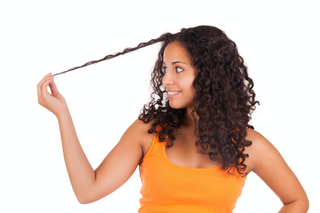Have you ever walked down the shampoo aisle and thought, none of this fits me? There are tons of products that claim to help oily hair and dry hair. But what if your hair is both? Don’t worry. We have five tips to care for combination hair.
Change Your Brush
If you already have an excess of oil at your roots while your ends are parched, take advantage of the situation and spread your natural oils around. Your body naturally makes sebum to help protect your hair, so it makes sense to use the oil you’re already producing to moisturize your ends.
Think of it this way–what you’re experiencing may be less of an excess oil problem and more of a distribution problem. You’re making the sebum your hair needs; it just needs some help to travel down your hair shaft. That’s where a natural brush comes in. Natural bristles are excellent for evenly distributing your hair’s natural oils from root to tip.
Lay Off the Heat
Using heat tools like blow dryers, curling irons, and straighteners only makes your hair woes worse. That’s because the heat dries out your locks. And in response, you may make even more sebum. So your ends are drier than when you started, and your scalp is greasier.
Instead, allow time for your hair to air dry after you shower. If you have naturally curly or wavy hair, try hair plopping to help keep your tresses under control. And experiment with styles that don’t require heat. We have some great suggestions here.
Wash Less Often
If you’re dealing with an oily scalp, washing less frequently seems like the exact opposite of what you should do. But if you’re washing your hair every day in an attempt to keep your hair from looking greasy, you’re probably exacerbating the problem. Shampooing strips your hair of oils, which is going to dry out your ends. And although it may initially rid your roots of oil, that’s actually going to trigger you to produce more sebum to replace what was lost.
Instead, aim to wash two or three times a week. And give your hair time to adjust to the routine. If your body thinks it needs to produce tons of sebum because it’s being stripped away every day, it might not instantly stop doing that. Over time, though, your hair should adjust, and you’ll find that it’s less greasy at the roots and more hydrated at the ends.
Use the Right Shampoo
Using the right shampoo is important. Try not to fall for gimmicks that promise instant results, and steer clear of harsh ingredients like sulfates and parabens that may make your problems worse.
Instead, opt for moisturizing ingredients like glycerine and aloe, along with natural oils that will moisturize your hair without leaving it greasy. We recommend Citrus Yao. The natural citrus oil cuts through excess sebum on your hair but won’t strip your strands.
Condition Every Time You Wash
Some people avoid conditioning because they think it will make oily hair worse. But that’s not true. Moisturizing your hair helps keep your ends from drying out. And when your hair is hydrated, you may produce less sebum in response.
Conditioner also seals your cuticles after they are opened during shampooing. If you skip that step, your cuticles are left open, allowing your hair to dry out even more.
Has Viori helped you care for your combination hair? Don’t forget to leave us a review!

